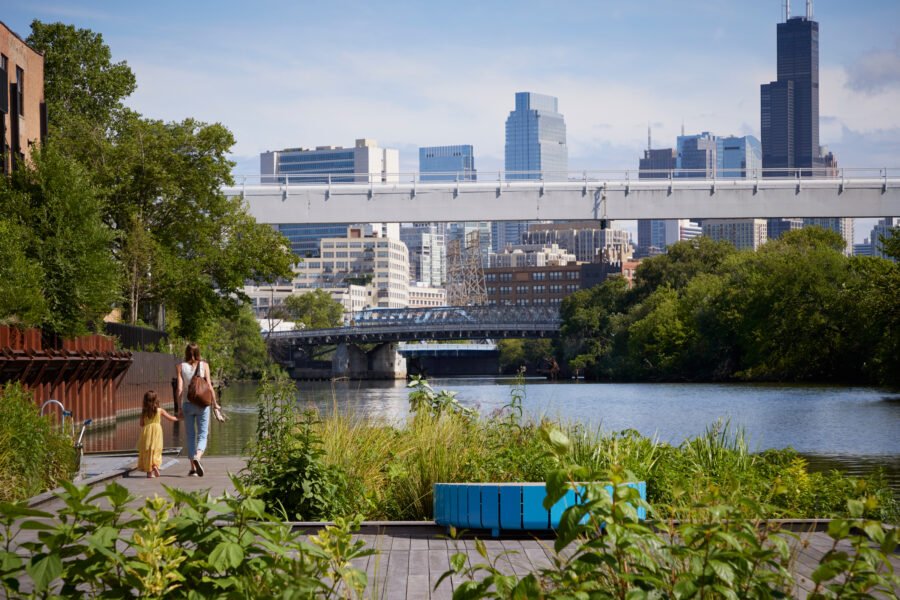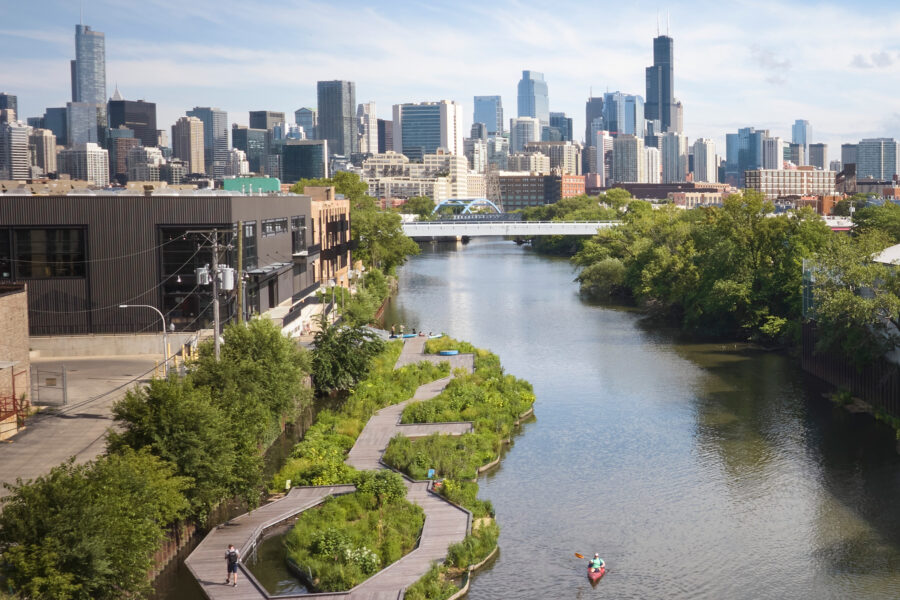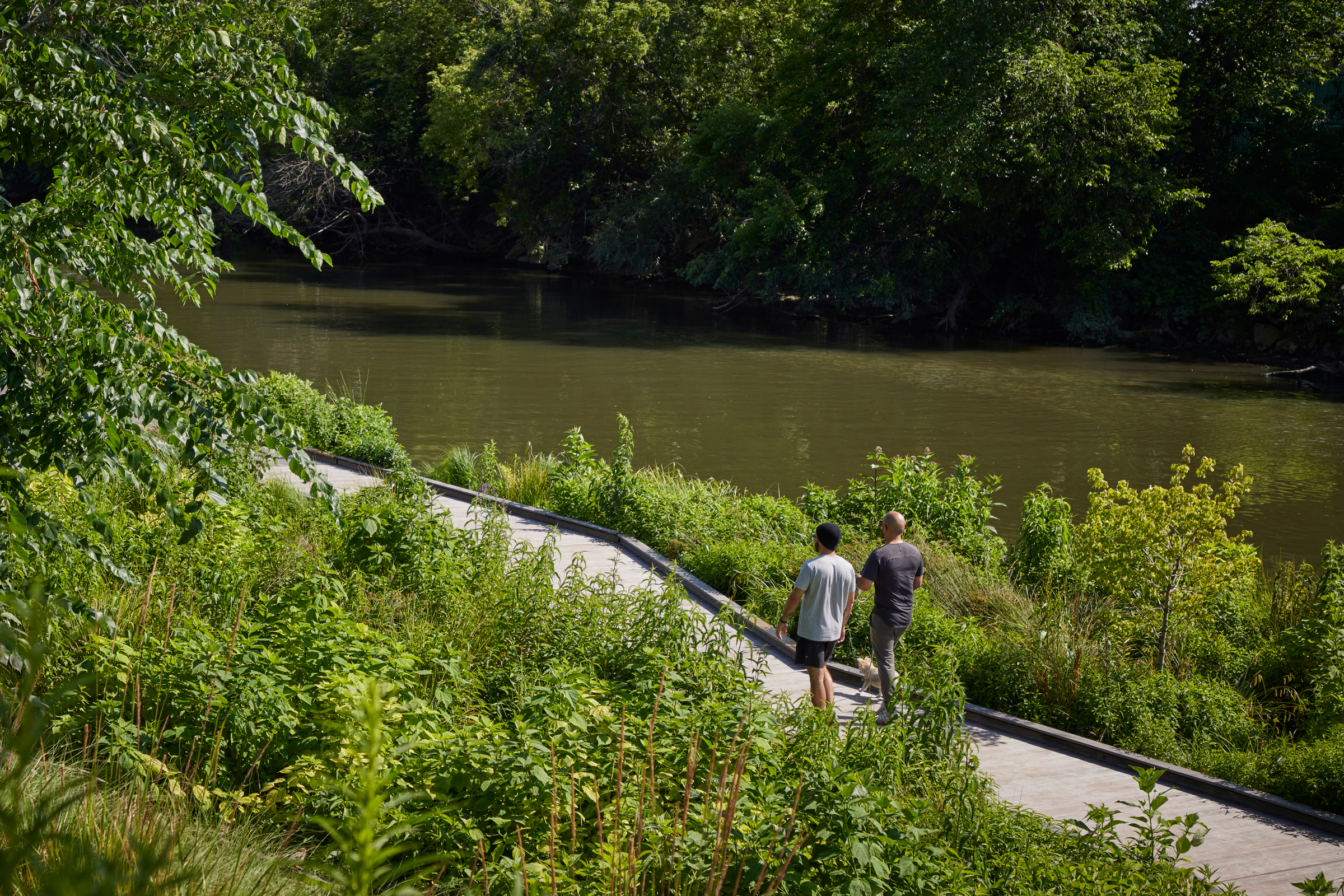Story at a glance:
- The Wild Mile is an evolving mile-long, interactive river restoration project that originated as part of a larger framework plan with the City of Chicago, Urban Rivers, and SOM.
- Projects like the Wild Mile highlight the importance of nature-based solutions in moving beyond single-purpose solutions.
- The Wild Mile will transform the area into an oasis of floating gardens, forests with public walkways, kayak docks, and other amenities.
I could not have been less prepared for a muskrat to pop its head up from a hole amid new plant life on a floating habitat in what was once a very industrial area. In fact, I didn’t even know if it was a muskrat. I had to look it up to confirm. It looked so happy.
“Yes, they should look so happy; we provide them with so many easy meals in the form of our native plants, but they are helping eat invasive mussels as well, so that’s something,” says Phil Nicodemus, research director with Urban Rivers, who studies and maintains the Wild Mile project.
This previously unlikely spot behind an REI and Off Color Brewing in Chicago is now home to the start of the Wild Mile—a floating eco park and public green space that is bringing life back to the Chicago River.
The water quality has improved. The number of fish species has increased in a very short time.
“The water quality has improved. The number of fish species has increased in a very short time. The nutrient levels in the river are starting to return,” says Doug Voigt, a partner at Skidmore, Owings, and Merrill (SOM). Voigt leads urban design at SOM and has been heavily involved in the riverfront project since its early stages. “There’s a lot of great evidence now that this first phase has been completed; you can really see the value and the importance of a project like this around green infrastructure.”
The Wild Mile is a planned mile-long, interactive river restoration project that originated as part of a larger framework plan with the City of Chicago, Urban Rivers, and SOM. This plan outlines potential development and green space expansion opportunities along the north branch of the river. The first phase of the project was completed in 2021, and phase two was scheduled to begin in summer 2024, as the Urban Rivers team planned to install the second 300 to 400 feet of floating wetlands and walkways with continued support from SOM in coordination, planning, and advocacy.
Already Voigt likes to walk down by the Wild Mile in all seasons. “Like a lot of Midwestern landscapes, it’s beautiful at all times of the year, if you have an appreciation for places like Chicago,” he muses.

The Wild Mile transforms a formerly industrial riverfront in Chicago. Photo by Dave Burk
As life returned to the area in spring, Voigt was taken not just by the greenery but also the many colorful plantings popping up. When I was there in April a pair of geese seemed to be protecting their eggs in the far corner of the park, honking furiously when gulls flew overhead. “When you’re down there it’s this immersive experience walking on this very intimate boardwalk. Being able to sit in nature and look back down the Chicago River to the skyline is a really unique experience,” Voigt says. Site furniture from Vestre, a Norway-based furniture company committed to sustainable manufacturing, dots the boardwalk.
This focus on the Chicago River dates back 20 years or more, and SOM has long been involved in helping not only provide public access but also to restore natural edge conditions. It all started when Urban Rivers, a grassroots organization, began to experiment with the floating wetlands concept. Voigt says it was low-tech at first—milk crates with soil and tomato plants to test the concept. Then they started to raise funds to develop the first floating habitat.
Voigt says those ideas took root in many different ways over the years, including a city plan in 2003 that was updated in 2008, showing illustrations of the initiative on the east side of Goose Island in Chicago. “It was not called the Wild Mile then, but the idea of creating additional park space, public access, and naturalizing the edges of the Chicago River outside of the core of the city were all part of that.”

When complete, the Wild Mile is designed to be a 17-acre floating eco-park. Photo by Dave Burk
Before the project got off the ground its advocates argued that the area’s channelized edges prevented native flora from establishing and were barriers for fauna, while surface runoff and combined sewer overflows contributed to poor water quality. Urban Rivers wanted to convert under-utilized industrial spaces like this one, use plants to improve water quality in the river, and become a local garden. It’s now well on its way as both a source of food and life for native plants and animals and a point of social connection for the area. Its location near businesses like REI and Whole Foods, too, have been beneficial as sources of corporate sponsorship.
“It’s an incredibly diverse group of collaborators who have worked on this project over many years,” Voigt says. “We had early workshops with scientists from the Shedd Museum and from Northwestern University. Then you have community groups like NeighborSpace and Friends of the River as well. It’s pretty incredible.”
The project faced challenges in that the majority of the land around the Wild Mile is privately owned, and the river is managed by the US Army Corps of Engineers. It required much effort to get all private parties to see the value of investing in the health of the river, then they had to get approvals from the federal government. “To do anything in that corridor you need not only support from the Army Corps of Engineers but to deauthorize a navigable channel requires an act of Congress,” Voigt says.
Through community-based planning work Urban Rivers and SOM found a way to add wetlands and public access within the first 20 feet of the retaining walls, working with the Army Corps. “In some ways it’s a park system developed on found land that doesn’t belong to the city, and it doesn’t belong to a private property owner. It’s an interesting set of solutions from a policy and overall approach of implementing green infrastructure in the public realm,” Voigt says.
The team leveraged existing infrastructure like the sheet pile along most of the channels to anchor the floating docks and garden beds. “We attached to that at certain points to bring access down to the water level, but the actual rafts are secured very carefully because this portion of the river, like most of the river, was industrialized. There are a lot of pollutants in the sediment at the floor of the river. There was a very careful anchoring and set of weights placed to minimize the amount of disruption to the sediment, which would then put pollutants back in the water. That was all very carefully considered and intentional in the design but also during the install.”
The continued work is inspiring other cities to look to Chicago for guidance. “Projects like the Wild Mile are a really great example of the creativity and innovation that’s happening throughout the city. Chicago is putting water innovation front and center,” Voigt says.
Cities of all sizes all over the globe have already reached out to see what they can learn from the project. “We get inquiries all the time—people wanting to learn from the Wild Mile and see how those lessons can be applied in their own community. In many ways we’re not only preserving but growing and strengthening habitat for all forms of life,” Voigt says.

Plantlife returns to the area now known as the Wilde Mile in Chicago. Photo by Dave Burk
He champions the Wild Mile as not simply solving a single problem. The project is also investing significantly in the community and has the potential to benefit people, plants, animals, and even the business community around it.
“We constantly look at these types of projects at multiple scales—from the benefits of the individual to the community to restoring habitat and biodiversity to its connection and place within the city and even the entire ecosystem,” Voigt says. “Projects like the Wild Mile highlight the importance of these nature-based solutions in moving beyond single-purpose solutions. These investments have the ability to bring transformative change in many different ways to the surrounding community.”




